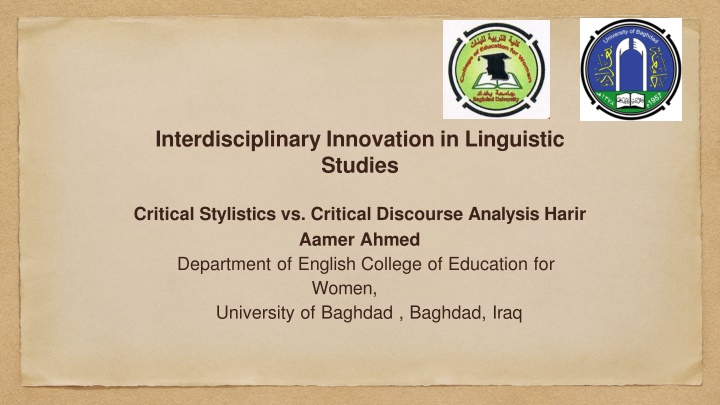
Innovative Analysis in Linguistic Studies: Critical Stylistics vs. Critical Discourse Analysis
Explore the intersection of Critical Stylistics and Critical Discourse Analysis within linguistic studies, uncovering interdisciplinary approaches and principles. Learn how Critical Discourse Analysis reacts to past models, mediates between social and linguistic theories, and reflects ideologies in discourse. Discover the unique perspective of Critical Stylistics in covering ideologies within text using analytical linguistic tools. Delve into the debate over comprehensive linguistic analysis tools offered by Critical Discourse Analysis versus Critical Stylistics.
Download Presentation

Please find below an Image/Link to download the presentation.
The content on the website is provided AS IS for your information and personal use only. It may not be sold, licensed, or shared on other websites without obtaining consent from the author. If you encounter any issues during the download, it is possible that the publisher has removed the file from their server.
You are allowed to download the files provided on this website for personal or commercial use, subject to the condition that they are used lawfully. All files are the property of their respective owners.
The content on the website is provided AS IS for your information and personal use only. It may not be sold, licensed, or shared on other websites without obtaining consent from the author.
E N D
Presentation Transcript
Interdisciplinary Innovation in Linguistic Studies Critical Stylistics vs. Critical Discourse Analysis Harir Aamer Ahmed Department of English College of Education for Women, University of Baghdad , Baghdad, Iraq
Critical Discourse Analysis Background to Critical Discourse Analysis A major fact about CDA is its interdisciplinarity that forms its basis in a variety
CDA is found in 'critical' developments in psychology, sociolinguistics, and social sciences as it is viewed to be a 'reaction' towards the social or uncritical models of the 1960s and 1970s (Van Dijk, 2015).
Chouliaraki and Fairclough (1999) add that CDA brings about a different range of theories whether linguistic or social theories, CDA mediates between social and linguistic in its theories.
Principles of Critical Discourse Analysis According to Fairclough and Wodak (1997, as cited in Paltridge, 2012), the primary principles of critical discourse analysis are the following: Social and political issues are constructed and reflected in discourse; Power relations are negotiated in discourse; Discourse both reflects and reproduces social relations ;and Ideologies are produced and reflected in the use of discourse.
Critical Stylistics It is the approach to language that is based on stylistics and critical discourse analysis. The founder of this approach is Lesley Jeffries who founds this approach to cover ideologies within texts by setting the appropriate analytical linguistic tools that critical discourse analysis lacks.
Jeffery (2010) comments that CDA does not offer a clear set of comprehensive tools to carry out the linguistic analysis. On the other hand, Critical
To sum up, it is obvious that for most of CDA work that the notion of power and dominance are what dominate texts to reproduce inequalities. While CDA puts ideology parallel to power, Critical stylist
